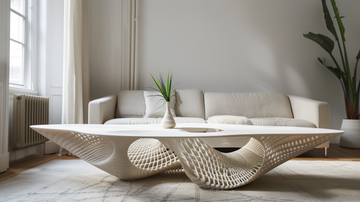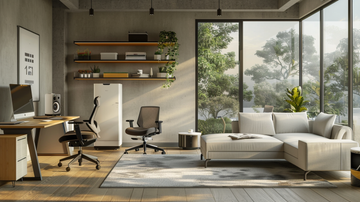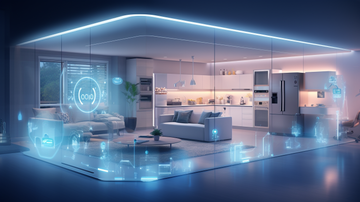What is 3D Furniture?
3D furniture refers to furniture pieces that are created using additive manufacturing technologies, commonly known as 3D printing. Unlike traditional furniture manufacturing methods that involve subtractive processes like cutting, carving, or molding, 3D printing builds objects layer by layer from digital 3D models. This technology allows for greater design freedom, customization, and the ability to create complex shapes and intricate details that would be difficult or impossible to achieve with conventional methods.
The key difference between 3D printed furniture and traditional furniture lies in the manufacturing process. While traditional furniture is typically made from solid materials like wood, metal, or plastic that are cut and assembled, 3D printed furniture is built up from materials like plastics, resins, or even concrete, one layer at a time, based on a digital 3D model. This additive process allows for a higher degree of geometric complexity and reduces material waste compared to subtractive manufacturing techniques.
One of the main advantages of 3D printed furniture is the ability to create highly customized and unique designs tailored to individual preferences or specific requirements. Additionally, 3D printing enables on-demand production, reducing the need for large-scale manufacturing facilities and inventory storage. However, it's important to note that 3D printing can be a relatively slow process, and the range of materials suitable for furniture production is still somewhat limited compared to traditional methods. Source
The Evolution of 3D Printing Technology
The origins of 3D printing can be traced back to the early 1980s, when Dr. Hideo Kodama of the Nagoya Municipal Industrial Research Institute invented one of the first additive manufacturing techniques, using a photopolymer to create 3D models layer by layer. (Source) This pioneering work laid the foundation for the development of modern 3D printing technology.
Over the years, advancements in materials, software, and hardware have revolutionized the 3D printing industry. From the early days of using photopolymers and plastics, the range of printable materials has expanded to include metals, ceramics, composites, and even biological materials. Techniques like stereolithography (SLA), fused deposition modeling (FDM), selective laser sintering (SLS), and direct metal laser sintering (DMLS) have emerged, enabling the creation of intricate and highly precise 3D printed objects.
The impact of 3D printing has been felt across various industries, from manufacturing and healthcare to aerospace and consumer goods. It has facilitated rapid prototyping, customized production, and the creation of complex geometries that were previously impossible or prohibitively expensive to produce through traditional manufacturing methods.
The Rise of 3D Furniture Models
The use of 3D furniture models has seen a significant rise in recent years, driven by advancements in 3D printing technology and the increasing demand for customization in the furniture industry. According to CGI Furniture, 3D modeling has become an essential tool for furniture businesses, allowing them to create detailed visualizations of their designs before production begins.
One of the key benefits of using 3D models for furniture design is the ability to visualize different materials, colors, and finishes, as highlighted by Adobe. This not only saves time and costs but also enables designers and manufacturers to explore various design options and make informed decisions before committing to production.
The popularity of 3D furniture models has skyrocketed among designers and manufacturers alike, as it streamlines the design process, reduces the need for physical prototypes, and facilitates collaboration across teams and locations. With the increasing demand for personalized and unique furniture pieces, 3D modeling has become an indispensable tool for catering to diverse consumer preferences.
Design and Customization Possibilities
One of the most significant advantages of 3D printed furniture is the virtually unlimited design possibilities it offers. Unlike traditional manufacturing methods, 3D printing allows for the creation of unique and complex shapes that would be impossible or prohibitively expensive to produce using conventional techniques. This opens up a world of creativity for designers and manufacturers, enabling them to bring their most innovative and intricate designs to life.
Moreover, 3D printing facilitates customization on an individual level, catering to specific preferences and needs. Customers can personalize furniture pieces to their exact specifications, ensuring a perfect fit for their living spaces or ergonomic requirements. From custom dimensions to personalized patterns and textures, 3D printed furniture offers a level of personalization that traditional mass-produced furniture simply cannot match. This customization extends beyond aesthetics, as 3D printing also allows for the optimization of furniture for specific functional requirements, such as improved strength, durability, or weight reduction. Source
Materials Used in 3D Printed Furniture
The materials used in 3D printed furniture play a crucial role in determining its durability, aesthetics, and sustainability. While plastics have traditionally been the most common choice, advancements in 3D printing technology have opened up new possibilities for using metals, composites, and even sustainable materials.
Plastics, such as PLA (Polylactic Acid) and ABS (Acrylonitrile Butadiene Styrene), are widely used due to their affordability, ease of printing, and a wide range of color options. However, their durability and resistance to environmental factors can be a concern. Source
Metals, like stainless steel and titanium, offer superior strength and longevity, making them suitable for load-bearing furniture components. However, metal 3D printing is generally more expensive and complex. Composites, such as carbon fiber reinforced plastics, combine the benefits of plastics and metals, offering strength and lightweight properties.
In recent years, there has been a growing interest in exploring sustainable and eco-friendly materials for 3D printed furniture. These include bioplastics derived from renewable resources like corn starch or wood fibers, as well as recycled plastics. While these materials may have limitations in terms of strength or printing capabilities, they align with the growing demand for environmentally conscious products.
3D Furniture Printing Processes
There are several 3D printing techniques used for creating furniture models, each with its own advantages and limitations. The most common methods include:
1. Fused Deposition Modeling (FDM): Also known as Fused Filament Fabrication (FFF), this technique involves extruding molten plastic filament layer by layer to create the desired shape. It is one of the most accessible and affordable methods for 3D printing furniture components. However, it can result in visible layer lines and may require post-processing for a smooth finish. Source: https://ultimaker.com/learn/3d-printing-in-furniture-design/
2. Stereolithography (SLA): This process uses a laser to cure liquid resin layer by layer, resulting in highly detailed and smooth surfaces. SLA-printed furniture can have intricate designs and a polished appearance, but the materials used are often more expensive and less durable than those used in FDM printing.
3. Selective Laser Sintering (SLS): SLS uses a laser to fuse powdered materials, such as nylon or polystyrene, into solid objects. This method is known for producing strong and durable furniture components, but the process is more expensive and requires specialized equipment.
Regardless of the technique used, post-processing steps like sanding, painting, or applying finishes may be necessary to achieve the desired aesthetic and durability for 3D printed furniture.
Applications and Use Cases
3D printed furniture has found applications in both residential and commercial settings. In the residential sector, homeowners can leverage 3D printing technology to create customized furniture pieces tailored to their unique living spaces and design preferences. This allows for a level of personalization that is difficult to achieve with traditional mass-produced furniture. From chairs and tables to shelving units and decorative items, 3D printing offers a new realm of possibilities for interior design enthusiasts. Source
The commercial sector has also embraced 3D printed furniture, particularly in the realm of event and exhibition design. Event organizers can utilize 3D printing to create eye-catching and unique furniture pieces that enhance the overall ambiance and experience of their events. These pieces can be designed to be lightweight, easily transportable, and even temporary, making them ideal for temporary installations or pop-up events.
Outdoor furniture is another area where 3D printing has made its mark. With the availability of weather-resistant materials, such as specialized plastics and composites, 3D printed outdoor furniture can withstand the elements while offering intricate designs and shapes that would be challenging to achieve through traditional manufacturing methods. Source
Cost and Affordability
One of the significant factors determining the widespread adoption of 3D printed furniture is its cost and affordability. Currently, the cost of 3D printed furniture remains higher than traditional manufacturing methods due to the specialized equipment, materials, and expertise required. According to Frame Web, the high initial investment in 3D printers and the relatively slow printing process contribute to the higher costs.
However, as the technology continues to evolve and become more mainstream, the costs are expected to decrease. Factors such as the development of more affordable 3D printers, the availability of a wider range of printing materials, and the optimization of printing processes could potentially reduce the overall cost of 3D printed furniture. Additionally, the ability to produce customized designs on-demand could offset some of the costs associated with traditional mass production and inventory management.
It is also worth noting that the cost of 3D printed furniture can vary significantly depending on the size, complexity, and materials used in the design. While smaller, simpler pieces may be more affordable, larger and intricate designs that require specialized materials or extensive printing time can be significantly more expensive.
Environmental Impact
One of the key advantages of 3D printed furniture is its potential for sustainability and reduced environmental impact. Traditional furniture manufacturing often generates significant waste, as materials are cut and shaped from larger pieces, leaving behind scraps and offcuts. In contrast, 3D printing is an additive process, where material is deposited layer by layer, resulting in far less waste.
Additionally, 3D printing allows for the use of recycled and renewable materials, such as recycled plastics, bioplastics, and even materials derived from agricultural waste. This not only reduces the demand for virgin materials but also helps to divert waste from landfills and oceans. Recent projects have demonstrated the potential of 3D printing to create sustainable and eco-friendly furniture, contributing to a more circular economy.
Furthermore, 3D printing can potentially reduce the carbon footprint associated with furniture production and transportation. By enabling on-demand and localized manufacturing, 3D printing can minimize the need for long-distance shipping and reduce the associated emissions. Additionally, some 3D printing processes, such as those using plant-based or recycled materials, have a lower energy consumption compared to traditional manufacturing methods.
The Future of 3D Furniture
The future of 3D furniture looks promising, with several trends and predictions pointing towards its widespread adoption. According to a report by FrameWeb (https://frameweb.com/article/sustainability/3d-printed-furniture-is-back-this-time-its-here-to-stay), the reemergence of 3D printing in industrial design could be a major driver in creating a more cost-efficient, sustainable, and customizable furniture industry.
One of the key opportunities lies in mass customization and on-demand manufacturing. 3D printing allows for unique, personalized designs that cater to individual preferences, enabling consumers to have a say in the furniture they purchase. Additionally, on-demand manufacturing eliminates the need for large inventory and reduces waste, aligning with the growing demand for sustainable practices.
However, challenges remain in terms of scalability, material limitations, and cost-effectiveness for large-scale production. As the technology continues to evolve and become more accessible, these challenges are expected to be addressed, paving the way for 3D printed furniture to become a mainstream option.







